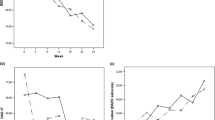Abstract
Cognitive therapy based on the proposals of Beck (1963)and Ellis (1970),and on Bandura (1971)and Marston (1964),was compared both with a behavioral approach derived from Ferster (1965),Lazarus (1968),and Lewinsohn (1974)and with a treatment that combined these two strategies. Twenty-eight mild to moderately depressed subjects were randomly allocated to one of the three groups or a no-treatment waiting list control group. The results indicated that the three treatment groups improved significantly more than waiting list controls on all measures, and there were no differences between the cognitive therapy alone and the behavioral intervention alone on any measure. However, the combined group was more effective than the average of either of its components alone in reducing depression as measured by Beck's Depression Inventory and Dempsey's (1964)D-30 Scale, and these results were replicated with the data derived from a self-esteem and a self-acceptance variant of Kelly's (1955)Repertory Grid. Similar, but nonsignificant, trends were observed on Aitken's (1969)Visual Analogue Scale (a subjective evaluation of depressed mood),on the Multiple Affect Adjective Checklist, and on Eysenck's Personality Inventory.
Similar content being viewed by others
References
Aitken, R. C. B. Measurement of feeling using visual analogue scales.Proceedings of the Royal Society of Medicine 1969,62 989–993.
Bandura, A.Principles of behavior modification. New York: Holt, Rinehart & Winston, 1969.
Bandura, A. Psychotherapy based on modeling principles. In A. E. Bergin & S. L. Garfield (Eds.),Handbook of psychotherapy and behavior change: An empirical analysis. New York: Wiley, 1971. Pp. 653–708.
Barber, T. X.Hypnosis: A scientific approach. New York: Van Nostrand, 1969.
Beck, A. T. Thinking and depression.Archives of General Psychiatry 1963,9 324–333.
Beck, A. T.Depression: Causes and treatment. Philadelphia: University of Pennsylvania Press, 1967.
Beck, A. T. Cognitive therapy: Nature and relation to behavior therapy.Behavior Therapy 1970,1 184–200.
Beck, A. T. The development of depression: A cognitive model. In R. Friedman & M. Katz (Eds.),Psychology of depression: Contemporary theory and research. New York: Winston-Wiley, 1974. Pp. 3–27.
Beck, A. T.Cognitive therapy and the emotional disorders. New York: International Universities Press, 1976.
Berecz, J. Aversion of fiat: The problem of “face validity” in behavior therapy.Behavior Therapy 1973,4 110–116.
Bibring, E. The mechanism of depression. In P. Greenacre (Ed.),Affective disorders. New York: International University Press, 1953. Pp. 13–48.
Dempsey, P. An undimensional depression scale for the MMPI.Journal of Consulting Psychology 1964,28 364–370.
Ellis, A.The essence of rational psychotherapy: A comprehensive approach to treatment. New York: Institute for Rational Living, 1970.
Fahy, T. J. Depression in hospital and in general practice: A direct clinical comparison.British Journal of Psychiatry 1974,124 240–242.
Ferster, C. B. Classification of behavioral pathology. In L. Krasner & L. P. Ullman (Eds.),Research in behavior modification. New York: Holt, Rinehart & Winston, 1965.
Ferster, C. B. A functional analysis of depression.American Psychologist 1973,28 857–870.
Grinker, R., Miller, J., Sabshin, M., Nunn, R., & Nunnally, J.The phenomena of depressions. New York: Hoeber, 1961.
Hays, W. L.Statistics for psychologists. New York: Holt, Rinehart & Winston, 1963.
Herron, E. W. The multiple affect check list: A critical analysis.Journal of Clinical Psychology 1969,25 46–53.
Jacobson, E.Depression: Comparative studies of normal, neurotic and psychotic conditions. New York: International Universities Press, 1971.
Johnson, W. G. Some applications of Homme's coverant control therapy: Two case reports.Behavior Therapy 1971,2 240–248.
Kelly, G. A.The psychology of personal constructs (Vol. 1). New York: Norton, 1955.
Lazarus, A. A. Learning theory and the treatment of depression.Behavior Research and Therapy 1968,6 83–89.
Lazarus, A. A. Multimodal behavior therapy: Treating the “BASIC ID.”Journal of Nervous and Mental Disease 1973,156 404–411.
Lewinsohn, P. M. Clinical and theoretical aspects of depression. In K. S. Calhoun, H. E. Adams, & K. M. Mitchel (Eds.),Innovative treatment methods in psychopathology. New York: Wiley, 1973.
Lewinsohn, P. M. The behavioral study and treatment of depression. In M. Hersen, R. M. Eisler, & P. M. Miller (Eds.),Progress in behavior modification (Vol. 1). New York: Academic Press, 1974.
Lewinsohn, P. M., & Shaw, D. A. Feedback about interpersonal behavior as an agent of behavior change: A case study in the treatment of depression.Psychotherapy and Psychosomatics 1969,17 82–88.
Lewinsohn, P. M., Weinstein, M. S., & Shaw, D. A. Depression: A clinical-research approach. In R. D. Rubin & C. M. Franks (Eds.),Advances in behavior therapy. New York: Academic Press, 1969. Pp. 231–260.
Liberman, R. P., & Raskin, D. E. Depression: A behavioral formulation.Archives of General Psychiatry 1971,24 515–523.
MacPhillamy, D. J., & Lewinsohn, P. M.Pleasant events schedule. University of Oregon, 1971. Mimeo.
Mahoney, M. J. The self-management of covert behavior: A case study.Behavior Therapy 1971,2 575–578.
Marston, A. Personality variables related to self-reinforcement.Journal of Psychology 1964,58 169–175.
Nelson, T. M. Student mood during a full academic year.Journal of Psychosomatic Research 1971,15 113–122.
Premack, D. Toward empirical laws: I. Positive reinforcement.Psychological Review 1959,66 219–233.
Prusoff, B. A., Klerman, G. L., & Paykel, E. S. Concordance between clinical assessments and patients' self-report in depression.Archives of General Psychiatry 1972,25 546–552.
Todd, F. J. Coverant control of self-evaluative responses in the treatment of depression: A new use for an old principle.Behavior Therapy 1972,1 91–94.
Wilcoxon, L. A., Schrader, S. L., & Nelson, R. E. Behavioral formulations of depression. In W. E. Craighead, A. E. Kazdin, & M. J. Mahoney (Eds.),Behavior modification: Principles, issues, and applications. Boston: Houghton Mifflin, 1976. Pp. 200–226.
Author information
Authors and Affiliations
Rights and permissions
About this article
Cite this article
Taylor, F.G., Marshall, W.L. Experimental analysis of a cognitive-behavioral therapy for depression. Cogn Ther Res 1, 59–72 (1977). https://doi.org/10.1007/BF01173505
Issue Date:
DOI: https://doi.org/10.1007/BF01173505




